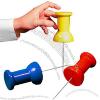Call it (Wilson) "combat" if you want (sounds more like a competition thing to me, not "combat") but I don't see the necessity to be able to shoot the 2nd eyelash on the left hand eye from 50' for $4000 dollars after a 200 rd break in period as a sign of "combat worthy".
Spend your money on whatever you want (it is still America, at least for a little while longer) including a status symbol but my ~$400 RIA will stop a threat just as well as your Wilson Combat, I just won't get the chance to tell everybody I spent $4000 to do it.
As far as Kahr, if the instruction manual tells me I have to shoot 1/3 the price of the gun in ammo in order to see if it's gonna work, that one's not for me.
There are 100 other small 9mm's that will satisfy my needs without that stipulation.
(And before anybody gets "upset" on me I shoot my guns to confirm function anyway, I just don't think you should told you have to before you can trust it)
Spend your money on whatever you want (it is still America, at least for a little while longer) including a status symbol but my ~$400 RIA will stop a threat just as well as your Wilson Combat, I just won't get the chance to tell everybody I spent $4000 to do it.
As far as Kahr, if the instruction manual tells me I have to shoot 1/3 the price of the gun in ammo in order to see if it's gonna work, that one's not for me.
There are 100 other small 9mm's that will satisfy my needs without that stipulation.
(And before anybody gets "upset" on me I shoot my guns to confirm function anyway, I just don't think you should told you have to before you can trust it)


